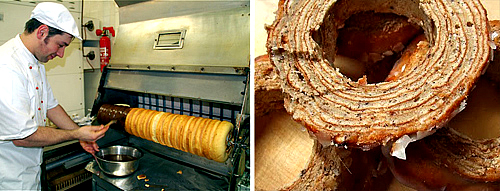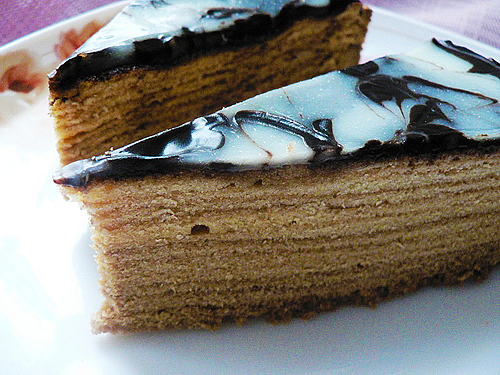Home
Architecture
Art
Beauty/Health
Beer
Business/Economy
Cars
Celebrities
Christmas
Dictionaries
Education
Fashion/Clothes
Food
Galleries
Gays/Lesbians
Genealogy
German Names
Germans Abroad
History
Holidays
Homework Help
Learn German
Law
Literature
Loveparade
Movies
Music
Nazi
News
Oktoberfest
Philosophy
Today in History
Traditions
Travel to Germany
Wines
More topics...
Facts About Germany
Armed Forces
Education
Economy
History
Geography
Mass Media
Politics
Society
German History
Early History
Medieval History
Thirty Years' War
Weimar Republic
Third Reich
Postwar
Honecker Era
Berlin Wall
Bismarck
German Recipes
Salads
Main Dishes
Desserts
Baking
German Chocolate Cake
Easter Dishes
Halloween Dishes
Christmas Dishes
How To in Germany
Articles
Quizzes
|
Baumkuchen
- the King of Cakes

A true test of a pastry chef's skills, the Baumkuchen has earned its
reputation as the "King of Cakes." This labor-intensive specialty gets
it name, which translates literally as Tree Cake, from the many thin rings
that form as layer upon layer of cake is baked. For more than 200 years
German bakers have been producing this treat by placing a thin spit over
a heat source, originally a wood fire, then evenly brushing batter over
it, giving each new layer a chance to bake to a golden brown before brushing
on the next. When the cake is removed and sliced, each layer is divided
from the next by a golden line, resembling the rings on a crosscut tree.
Skilled pastry chefs have been known to create cakes with 25 layers, weighing
over 100 pounds and measuring more than 3 feet long. The recipe here is
adapted for the home baker and uses a springform pan instead of a spit.
Of course the ring effect won't be exactly the same, but the taste is
still worth the effort and you won't have to spend your Christmas holiday
cleaning drips of burned batter off the oven.

Ingredients:
*-*-*-*-*-*-*-*-*-*-*-*-*-*-*-*-*-*-*-*-*-*
- 7/8 cup unsalted butter, softened
- 1 cup sifted confectioners' sugar
- 7/8 cup cornstarch
- 2 tbsp rum
- 5 1/2 ounces almond paste
- 1 1/2 teaspoons vanilla extract
- 1 pinch salt
- 2 egg yolks
- 6 egg whites
- 3/4 cup white sugar
- 3/4 cup all-purpose flour
- 1/2 cup apricot jam, melted
- 9 (1 ounce) squares semisweet chocolate
- 2 1/2 teaspoons vegetable oil
Cooking:
*-*-*-*-*-*-*-*-*-*-*-*-*-*-*-*-*-*-*-*-*-*
- Whip butter and sugar well until creamy.
- Gradually add egg yolks and
the remaining ingredients to the butter-sugar mixture until a light, foamy
batter forms.
- Beat egg whites until very stiff and stir gently into the
batter.
- Pour about 2 tablespoons batter (a thin covering) into a 8-1/2"
springform pan greased with butter.
- On the uppermost oven rack, bake (or
broil) in a preheated oven at 450° F for 2 minutes or until golden brown.
Watch carefully, this browning can take place very quickly.
- Repeat until
all the batter is gone -- you should have about 14 to 16 layers.
- When
the cake is done, let it stand a few minutes before running a sharp knife
along the sides of the pan. Remove the cake from the pan and glaze with
melted apricot jam.
- Once the jam is set, you can add an additional glaze
of thinned almond paste or immediately finish the cake with a thin icing
made from powered sugar or
your favorite chocolate, melted with vegetable oil.
More German Recipes
|
|




